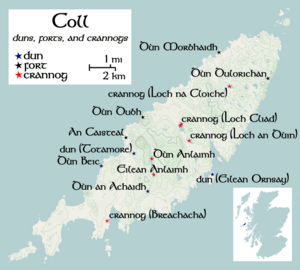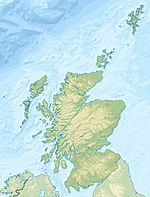Dùn Dubh facts for kids
Dùn Dubh is an ancient hillfort found on the island of Coll in the Inner Hebrides. People in the area have a long-standing tradition about this fort. They say it was one of three strongholds once held by Norsemen, who were later defeated by a powerful Maclean chieftain. An expert from the early 1900s, Erskine Beveridge, thought Dùn Dubh was one of the most interesting forts on Coll.
Contents
What's in a Name?
The name Dùn Dubh comes from Scottish Gaelic. It means "the black dun". A "dun" is an old word for a fort or stronghold.
Where is Dùn Dubh?
Dùn Dubh is located on a rocky ridge. This ridge is on the northern coast of Coll. It sits about 620 meters (2,030 feet) north-northeast of a place called Clabhach.
What Does the Fort Look Like?
The fort is built on a long, rocky ridge. This ridge runs from the northwest to the southeast. One end of the ridge has a high, rocky area. The other end has several flat sections, like steps. These steps drop very steeply on the west side. They drop almost straight down on the south side.
Beveridge believed the fort was built in a very strong spot. This is because the west and south sides were almost impossible to reach. They had very steep cliffs.
Fort Walls
The eastern side of the ridge has several walls for protection. The innermost wall is called wall 'A'. It runs along the top of the ridge. This wall is about 0.3 meters (1 foot) high in some places. Its inner part reaches about 1 meter (3 feet) tall.
Inside wall 'A', you can find the remains of two stone enclosures. These are roundish areas made of stones. The stones likely came from the fort's ruins. The larger enclosure is about 4.6 by 3.7 meters (15 by 12 feet) inside. It stands about 0.5 meters (1.6 feet) tall. Only the base of the other enclosure remains.
About 2.5 meters (8 feet) down the slope from wall 'A' is another wall, called wall 'B'. This wall is about 1 meter (3 feet) tall in some parts. The northeast side of the fort has another wall. This wall is best preserved at 1.2 meters (4 feet) high. One part of this northern wall blocks a narrow gully.
The Well
Beveridge also mentioned a ravine (a deep, narrow valley) about 30 meters (98 feet) north of the fort. He thought he saw a pile of large stones there. These stones looked like they once formed a well. However, when the Ordnance Survey visited in 1972, they could not find the well. They believed any stones in the area were from the fort itself. Still, a 1976 map shows a well about 50 meters (164 feet) southeast of the fort.
What Was Found at Dùn Dubh?
When experts explored Dùn Dubh, they found several interesting items. These included hammerstones, which are stones used for hammering. They also found pieces of rough pottery. Small, rounded pebbles were also discovered. These pebbles were similar to ones found at another fort called Dùn Beic.
Old Stories About Dùn Dubh
People on Coll have many old stories about the forts on the island. Dùn Dubh is part of these traditions. One popular story tells of a time when Norsemen lived in these forts.
The Norsemen and Maclean
One story was written down in 1895 by Rev. John Gregorson Campbell. It says that the Laird of Dowart (a Maclean chief) was going to collect rent on Tiree. He sent someone to Coll for food. A woman there said the Maclean chief wasn't worth feeding. She said this because he hadn't taken Coll for himself.
At that time, three brothers from Lochlann (a Norse land) controlled Coll. One brother, Annla Mòr, lived in a fort at Loch Annla. Another lived in Dùn Bithig. The third brother lived on Grisipol hill, likely at Dùn Dubh. The woman told the chief she had thirty men ready to fight.
The Maclean chief went to Annla's fort alone one evening. He was welcomed kindly. Annla's arrows were near the fire. The chief slowly moved closer and managed to take them. This led to a fight at Grimsari. This story might explain why the chief encouraged Iain Garbh to take control of Coll. Iain Garbh is believed to be the ancestor of the Macleans of Coll.
Another Version of the Story
In 1903, Erskine Beveridge heard another version of this story. This version said the events happened in 1384. However, this date was likely calculated much later. It was based on how long the Macleans of Coll were thought to have owned their land. Historical records show the Macleans were granted Coll in 1409.
Beveridge's version says that a Norse chief lived in Dùn Anlaimh. He held Coll long after other Norsemen left nearby islands. Maclean of Duart already owned Tiree. One of his sons decided to attack the Norseman. The Norsemen, realizing they were beaten, threw their weapons into the loch. They did this so their enemies couldn't use them.
Another similar version was published in 1922 by Rev. Dugald MacEchern. It also mentions the Maclean chief being told he wasn't worthy. This was because he allowed Norsemen to control Coll. He then attacked the three Norse brothers. The fight took place at Grimsary.
These stories show the long history of battles and changes in power on the island of Coll.



